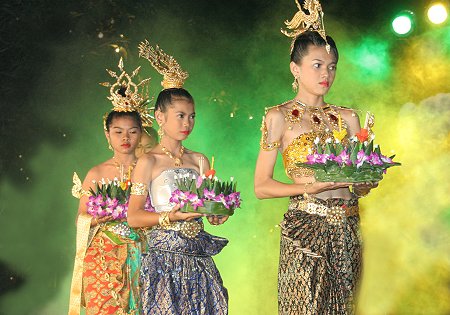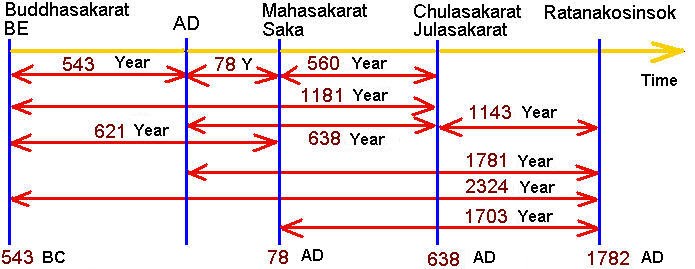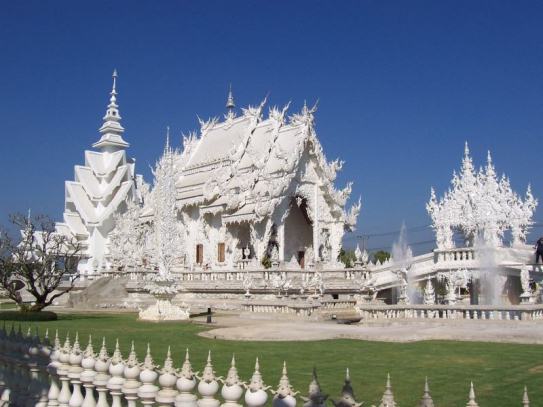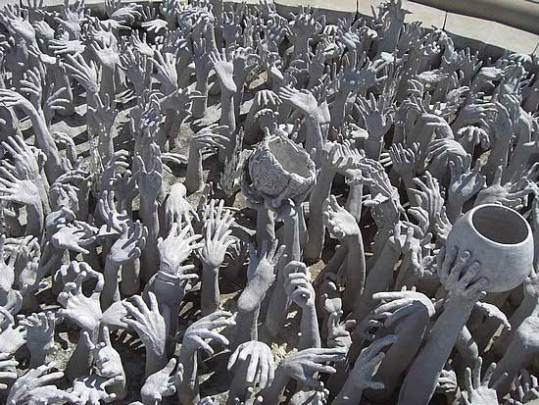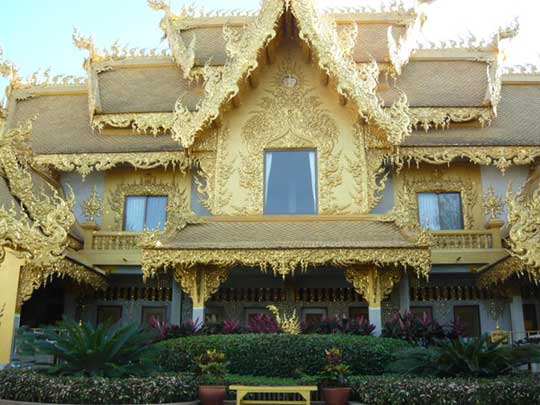The main food in Thailand is rice. Everyone has eaten it since they were born. But we can't really eat rice alone so we have to have something to go with it. There are many dishes of food to go with rice. Most of them are hot and spicy and that is what Thai food is famous for.
Thai people are used to eating rice with their meal. Most Thai people can't have sandwiches for their meal. They call sandwiches a snack. Also, most Thai people do not sit down to eat a proper meal because they usually eat when they are hungry, especially kids and teenagers. If you know some Thai person, you might hear them say "gin khao yung" every time you meet them. It means "have you eaten yet?" or more precise "have you eaten rice yet?". If you come to Thailand and stay with a Thai family then be careful you don't put on too much weight! All of the visitors that have come to stay at our school always go home weighing more!
Thai food is widely known for being hot and spicy since almost all Thai food is cooked with basic ingredients such as garlic, chillies, limejuice, lemon grass and fresh coriander leaf and fermented fish sauce (nam pia) or shrimp paste (kapi) to make it salty.
Thai food is eaten with a fork and spoon. Even single dish meals such as fried rice with pork, or steamed rice topped with roasted duck, are served in bite-sized slices or chunks obviating the need for a knife. The spoon is used to convey food to the mouth. Ideally, eating Thai food is a communal affair involving two or more people, principally because the greater the number of diners the greater the number of dishes ordered. Generally speaking, two diners order three dishes in addition to their own individual plates of steamed rice,
three diners four dishes, and so on. Diners choose whatever they require from shared dishes and generally add it to their own rice. Soups are enjoyed concurrently with rice. Soups are enjoyed concurrently with other dishes, not independently. Spicy dishes, not independently. Spicy dishes are "balanced" by bland dishes to avoid discomfort.
The ideal Thai meal is a harmonious blend of the spicy, the subtle, the sweet and sour, and is meant to be equally satisfying to eye, nose and palate. A typical meal might include a clear soup (perhaps bitter melons stuffed with minced pork), a steamed dish (mussels in curry sauce), a fried dish (fish with ginger), a hot salad (beef slices on a bed of lettuce, onions, chillies, mint and lemon juice) and a variety of sauces into which food is dipped. This would be followed by sweet desserts and/or fresh fruits such as mangoes, durian, jackfruit, papaya, grapes or melon.
The ideal Thai meal is a harmonious blend of the spicy, the subtle, the sweet and sour, and is meant to be equally satisfying to eye, nose and palate. A typical meal might include a clear soup (perhaps bitter melons stuffed with minced pork), a steamed dish (mussels in curry sauce), a fried dish (fish with ginger), a hot salad (beef slices on a bed of lettuce, onions, chillies, mint and lemon juice) and a variety of sauces into which food is dipped. This would be followed by sweet desserts and/or fresh fruits such as mangoes, durian, jackfruit, papaya, grapes or melon.
Since rice is the staple food in Thailand, it is usually eaten at every meal with soups, curries, fried vegetables and nam phrik. Nam phrik is a hot sauce, prepared in a variety of ways and differs from region t oregion: nam phrik pla pon is a ground dried fish and chilli sauce, nam phrik pla raa is a fermented fish and chilli sauce, nam phrik kapi is a shrimp paste and chilli sauce, nam phrik oong is a minced pork, tomato and chilli sauce. In general, the basic ingredients of nam phrik include shrimp paste, garlic, chilli, fermented fish sauce and iemon juice.
Other common seasoning in Thai food include galingale (khaa), blackpapper, ground peanut, tamarind juice, ginger and coconut milk. As a result, it takes hours to prepare a proper Thai meal in the traditional way as it involves so much peeling and chopping and pounding so it needs time to prepare in advance.
In fact, Thai food varies from region to region, for example, glutinous or sticky rice is more popular in the North and Northeast than steamed rice. Moreover, in some rural areas, certain insects are also eaten e.g. crickets, silk worm larvae, red ant larvae. At the same time, Thai desserts are often made from sticky rice or coconut milk, flour, egg and coconut sugar while a variety of fruit is available all the year round.
Meanwhile, the basic characteristic taste of Thai food in different parts of the country can be described in different ways: in the central region, food is hot, salty, sweet and sour. Rice is served with different types of nam phrik and soups e.g. tom yam kung (prawn soup with lemon grass. Dishes usually contain a lot of condiments and spices. In the North, food is mild or hot, salty and sour, but never sweet. Sticky rice is served with boiled vegetables, nam phrik oong and soups or curries. The North is also well-known for its sausage called "naem" which consists of fermented minced pork. It has a sour flavour and is sold wrapped in cellophane and banana leaf.
Food in the Northeast is hot, salty and sour. Their favourite foods include papaya salad (som tam), sour chopped meat salad "koi", sour minced meat salad (lard) . People use a lot of condiments but not many spices. Their meals generally consists of sticky rice and nam phrik pla raa accompanid by a lot of vegetableas including those found growing wild. On the other hand, food in the South is renowned for being very hot, salty and sour-tasting. Curries are popular and made with a lot of spices and condiments. Khao yam (a mixture of rice) raw vegetables and fermented fish sauce or boo doo is also a common dish. Generally southern people eat little meat and other varieties of nam phrik are not so popular, the most common one is nam phrik kapi.
Though the major portion of Thai food is described as being spiced and chilli hot, it currently enjoys worldwide popularity especially the exotic Tom Yam Kung, a uniquely piquant prawn soup that is renowned for it simplicity, creativity, artistic flair and delicious taste. Above all, the tastes of Thai cuisines can be amended to suit individual desire, for example, by reducing the amount of chillies in certain dishes to lower the heat or increasing amount of lime juice to increase sourness. Visitors who have tried the exotic Thai food will never forget to order them again whenever their favourite dishes are available.
Titbits
A simple kind of titbit is fun to make. You need shallots, ginger, lemon or lime, lemon grass, roasted peanuts and red phrik khi nu chilies. Peeled shallots and ginger should be cut into small fingertip sizes. Diced lime and slices of lemon grass should be cut to the same size. Roasted peanut should be left in halves. Chilies should be thinly sliced. Combinations of such ingredients should be wrapped in fresh lettuce leaves and laced with a sweet-salty sauce made from fish sauce, sugar, dried shrimps and lime juice.
Dips
Mixing crushed fresh chilies with fish sauce and a dash of lime juice makes a general accompanying sauce for any Thai dish. Adding some crushed garlic and a tiny amount of roasted or raw shrimp paste transforms it into an all-purpose dip (nam phrik). Some pulverized dried shrimp and julienned egg-plant with sugar makes this dip more complete. Serve it with steamed rice, an omelets and some vegetables.
Salad Dressings
Salad dressings have similar base ingredients. Add fish sauce, lime juice and sugar to enhance saltiness, sourness and sweetness. Crushed chilies, garlic and shallots add spiciness and herbal fragrance. Lemon grass and galangal can be added for additional flavour. Employ this mix with any boiled, grilled or fried meat. Lettuce leaves, sliced cucumber, cut spring onions and coriander leaves help top off a salad dressing.
Soup Stocks
Soups generally need good stock. Add to boiling water crushed peppercorns, salt, garlic, shallots, coriander roots, and the meats or cuts of one's choice. After prolonged boiling and simmering , you have the basic stock of common Thai soups. Additional galangal, lemon grass, kefir lime leaves, crushed fresh chilies, fish sauce and lime juice create the basic stock for a Tom Yam.
Curries
To make a quick curry, fry curry or chili paste in heated oil or thick coconut milk. Stir and fry until the paste is well cooked and add meats of one's choice. Season with fish sauce or sugar to taste. Add water or thin coconut milk to make curry go a longer way. Add sliced eggplant with a garnish of basil and kefir lime leaves. Make your own curry paste by blending fresh (preferably dried) chilies, garlic, shallots, galangal, lemon grass, coriander roots, ground pepper, kefir lime peels and shrimp paste.
To make a quick curry, fry curry or chili paste in heated oil or thick coconut milk. Stir and fry until the paste is well cooked and add meats of one's choice. Season with fish sauce or sugar to taste. Add water or thin coconut milk to make curry go a longer way. Add sliced eggplant with a garnish of basil and kefir lime leaves. Make your own curry paste by blending fresh (preferably dried) chilies, garlic, shallots, galangal, lemon grass, coriander roots, ground pepper, kefir lime peels and shrimp paste.
Single Dish Meals
Heat the cooking oil, fry in a mixture of crushed chilies, minced garlic, ground pepper and chopped chicken meat. When nearly cooked, add vegetables such as cut beans or eggplants. Season with fish sauce and garnish with kefir lime leaves, basil or balsam leaves. Cooked rice or fresh noodles added to the frying would make this a substantial meal.










 "Loy" means float and "Krathong" is usually a lotus-shaped raft. There are many legends about Krathongs, who and when and why they have been created. However, there is an evidence on stone script from Sukhothai period (about 700 years ago) that there was a festival floating lanterns which is believed to be the same as "Loy Krathong" festival now.
"Loy" means float and "Krathong" is usually a lotus-shaped raft. There are many legends about Krathongs, who and when and why they have been created. However, there is an evidence on stone script from Sukhothai period (about 700 years ago) that there was a festival floating lanterns which is believed to be the same as "Loy Krathong" festival now.
 Krathongs can be made using various materials. The traditional krathong uses banana trunk and banana leaves folding in many styles as main base materials Then the materials have been changed over time, foam and colored paper had been widely used instead. Until people recognized that foam and non-natural materials caused high water pollution and harm the fish. So natural materials gain popularity in use again. Some krathongs are made with bread that can be food for the fish later.
Krathongs can be made using various materials. The traditional krathong uses banana trunk and banana leaves folding in many styles as main base materials Then the materials have been changed over time, foam and colored paper had been widely used instead. Until people recognized that foam and non-natural materials caused high water pollution and harm the fish. So natural materials gain popularity in use again. Some krathongs are made with bread that can be food for the fish later. Traditional style krathong will be made of banana leaves, banana trunk decorated with flowers
Traditional style krathong will be made of banana leaves, banana trunk decorated with flowers  This kind of krathong is attractive to small kids due to its colorful and bright colors. This style was once widely used, but not anymore as they create water pollution.
This kind of krathong is attractive to small kids due to its colorful and bright colors. This style was once widely used, but not anymore as they create water pollution.  New krathong bread-based materials are developed lately as they can then be food for the fish.
New krathong bread-based materials are developed lately as they can then be food for the fish. 



 Inside floating lantern or "Khom Loy", it is called "Wowhom" or "Wowkwan" in northern dialect.
Inside floating lantern or "Khom Loy", it is called "Wowhom" or "Wowkwan" in northern dialect.  Hanging lanterns or "Khom Kwan"
Hanging lanterns or "Khom Kwan"
